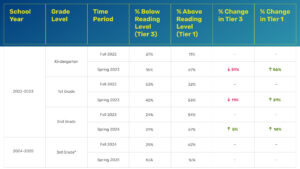Three years ago, Central Point Elementary School in Central Point, Oregon, partnered with IMSE to drive better literacy outcomes and improve alignment between tier one and tier two instruction by integrating the science of reading. Recognizing that many students were struggling with reading, the school turned to IMSE as the key to building a stronger foundation for literacy success.
Central Point, a Title I school with 450 students — 10% of whom are English learners (EL) and about 50% experiencing poverty — has led district-wide efforts to integrate the Orton-Gillingham approach as its primary intervention strategy. By collaborating closely with teachers, the school has successfully realigned its instructional methods to the Orton-Gillingham framework, improving literacy outcomes for all students, specifically those in grades K-2.
The Proof is in the Results
The K-2 team was trained three years ago, and since then, the school has continued to refine how the approach is implemented in the classroom, working to develop a curriculum that stays true to IMSE’s proven methodology. The training has had a profound impact, and the Central Point teachers have found the program to be one of the most practical and comprehensive professional development experiences they’ve had.
“Now in its third year of implementation, IMSE’s methods have truly inspired teachers, empowering them to refine their practices and develop a curriculum with the highest level of fidelity,” said Cara Taylor, Assistant Principal at Central Point Elementary.
While the school is still working to expand Orton-Gillingham strategies into grade levels beyond K-2, the success seen in younger students has only reinforced the importance of literacy instruction rooted in the science of reading.
Based on data from second and third-graders during the 2023-2024 school year, after receiving two years of Orton-Gillingham instruction:
 *2024-2025 3rd grade students received Orton-Gillingham instruction in 1st and 2nd grade.
*2024-2025 3rd grade students received Orton-Gillingham instruction in 1st and 2nd grade.
“The training was invaluable and our teachers have taken so much away from it,” said Cara. “It has helped our staff become more confident in teaching foundational reading skills, and that shared commitment among our educators is also helping to drive better student outcomes.”
The key takeaway is that while curriculum changes take time to fully impact a school’s literacy outcomes, the science of reading and evidence-based approaches are essential for building a strong foundation for student success in literacy. When teachers unite around strategies that have proven to transform student learning, their shared commitment drives the lasting change needed to strengthen literacy instruction and student outcomes.
Like what you read?

 *2024-2025 3rd grade students received Orton-Gillingham instruction in 1st and 2nd grade.
*2024-2025 3rd grade students received Orton-Gillingham instruction in 1st and 2nd grade.